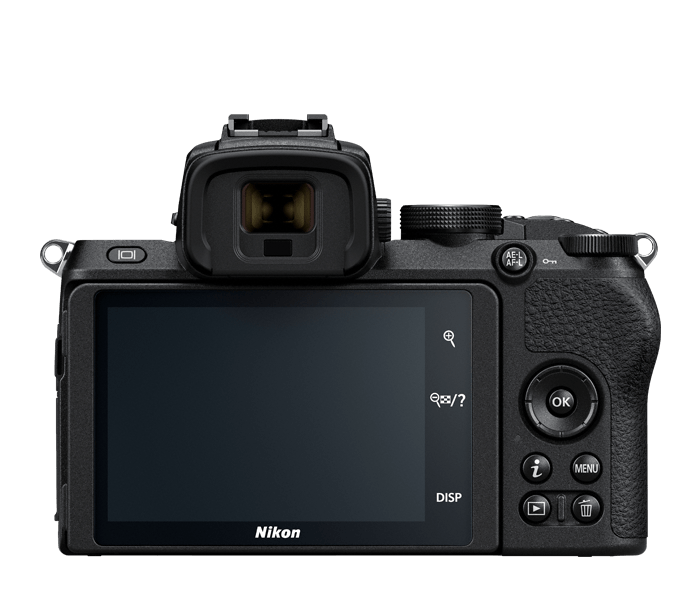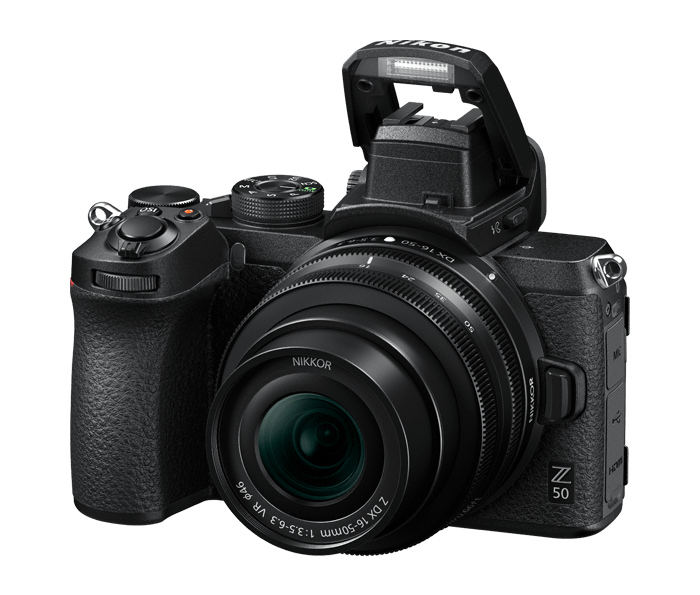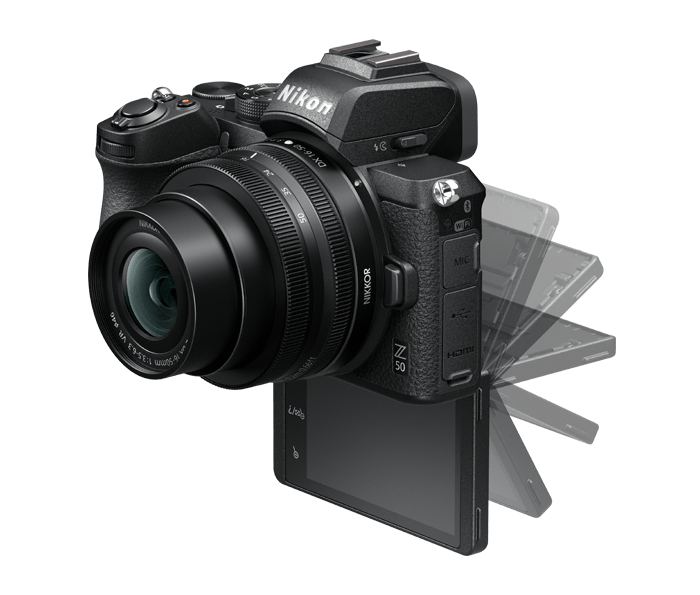Lens Logic Verdict
The Nikon Z50 is a great camera if you want something small, easy to carry, and powerful. It’s perfect for new and experienced photographers. You get sharp photos, clear videos, and a simple layout that’s easy to use. The camera focuses fast, and the viewfinder looks sharp, helping you capture great shots every time. You can use many Nikon Z-mount lenses, which gives you lots of options. It doesn’t have built-in image stabilization, but it’s still an excellent choice for anyone who wants quality in a small package. Overall, the Nikon Z50 is a smart pick.
TODAY’S BEST DEALS Check Amazon
Pros
- Compact and Lightweight Design
- Excellent Autofocus System
- 4K Video Recording
- High Image Quality
Cons
- Body Image Stabilization
- Limited Native DX Lenses
- Moderate Battery Life
Why you can trust Lens Logic? we put hours into testing each product or service we review. This way, you know you’re getting the best. Learn more about our testing process.

Mason knows photography inside and out. With 15 years of hands-on experience, he’s written about cameras, lenses, and gear of all kinds. He even spent five years as a journalist, diving deep into music and writing sharp, engaging stories. Now, Mason shares his photography knowledge, helping readers find the right gear and perfect their skills. He’s also proud of his unbeatable Wordle streak!
Jump to
If you want a Nikon Z-series camera but don’t want to spend a lot, the Nikon Z50 is a great pick. It’s the first APS-C (DX format) camera in the Z series, and it’s small, tough, and ready to take impressive photos and videos. The Z50 is designed for beginners and people who love taking photos and videos on the go. You get pro-level features without the heavy or expensive full-frame models like the Z6 or Z7.
This camera fits easily in your bag, so it’s perfect for travel, vlogging, and casual photo shoots. It’s simple to use, offers sharp focus, and connects with any Z-mount lens, making it versatile. The Z50 delivers great results for the price, with a strong autofocus and user-friendly design. Overall, the Z50 is perfect for anyone who needs a reliable camera that’s powerful, portable, and easy on the wallet.
Nikon Z50: SPECIFICATIONS
- Sensor: 20.9MP APS-C CMOS
- Image Processor: EXPEED 6
- Lens Mount: Nikon Z-mount
- Autofocus: Hybrid AF with 209 focus points
- ISO Range: 100-51,200 (expandable to 204,800)
- Video: 4K UHD at 30p, Full HD at 120p
- Viewfinder: 2.36M-dot OLED EVF
- Memory Card: Single UHS-I SD slot
- LCD: 3.2-inch tilting touchscreen, 1.04M dots
- Max Burst: 11 fps with AF/AE
- Connectivity: Wi-Fi, Bluetooth
- Size: 126.5 x 93.5 x 60 mm (5 x 3.7 x 2.4 in)
- Weight: 395g (0.87 lbs) with battery and memory card
Key Features of the Nikon Z50
With a number of remarkable features, it justifies its title as a compact as well as a powerful mirrorless camera fit for still shooters and video recorders. Let’s take a more detailed look at the specifics that set the Z50 apart from the rest of its lineup in the first place:
Sensor and Processor
Nikon utilizes a 20.9MP APS-C (DX-format) CMOS sensor with the Z50, which is integrated with the Nikon EXPEED 6 image processing chip. As a result of the combination, the camera produces images that have precise details, sound color reproduction, and minimum noise, even when used in the most challenging light conditions. It doesn’t matter whether you are shooting on a bright sunny day or in a dimly lit room; the performance of the sensor is the same. The EXPEED 6 processor also renders high processing capabilities, making the frame rate of continuous shooting as high as 11 frames per second for shooting fast action. Moreover, this combination also allows the photographer to shoot in 14-bit RAW so that there is more freedom during post-editing.
Autofocus System
A hybrid focus system that merges contrast detection with phase detection focusing methods is one of the notable features of Z50. It has 209 phase-detection and contrast-detection coverage points, which is around 90% of the frame. This ensures locking on subjects’ fast, accurate focusing and the ability to track edges of the types of view quickly. The inclusion of eye-detection autofocus is most welcome for portrait specialists, with eye autofocus working for people or animals always getting in sharp focus. This AF system achieves good results in both video and still image capture, and tracking is provided even at the most rapid rate of shooting scenes.
Video Capabilities
The Z50 is an advantage for videographers recording 4K UHD at 30 ISA with no crop, which allows for wide-angle shots to be made with the maximum opening without losing a valuable field of vision. It supports full HD video that shoots up to 120 fps and allows for the production of slow-motion videos very smoothly. Furthermore, the camera has an external microphone jack for plugging most muffs and recording sounds for their videos, which makes z50 a good camera for vloggers and content makers.
Connectivity and feature
To allow for the sharing of images and the wireless control of the camera through the Nikon SnapBridge application, Nikon has also incorporated modern connectivity options such as Wi-Fi and Bluetooth into the Z50. This is great for social media creators who are always on the go. With USB-C charging, users can charge the camera while in transit, which is particularly useful for frequent travelers.











Build and Design of the Nikon Z50
Compact and Lightweight Build
The Nikon Z50 is designed for mobility. Thus, it is best suited for those who like taking pictures or shooting videos while traveling. At 395 grams (body only), the Z50 weights almost nothing, which means carrying the camera when going on travels, doing street photography, or any type of shooting where you are always on the move is relatively easy. Despite the small size of the camera, it possesses a robust magnesium frame to withstand abuse. The deep grip, borrowed from the larger Z-series models, is comfortable to the point of being secure, even during prolonged periods of shooting; it is adequate to prevent hand-slipping without looking bulky.
LCD and Viewfinder
The Z50 uses a 3.2-inch touchscreen with a 1.04 million dots resolution, which can be adjusted, allowing the user to compose photos taken from different angles spectacularly, for example, from the floor. For vloggers and content creators, this tilting design works great because these people need to aim the camera quickly when they stand in front of it. Moreover, this specific touchscreen is complemented by a 2.36 million dot resolution OLED of Z50 and an electronic viewfinder, which allows you to see very bright areas in great detail and always gives precise framing and focus of the shot.
Ergonomics and Controls
With the vision of making its products easier for users to use, Nikon has simplified the button layout. The controls are simple to use and enable essential settings to be changed quickly without having to search through several menus. The presence of programmable function buttons is also beneficial, as the users can set their preferred functions that can be used quickly when taking pictures. All in all, the Z50 is built and designed in such a manner that it is sturdy, compact and comfortable to use.
Performance of the Nikon Z50
Autofocus Performance
The Nikon Z50 stands out across a multitude of shooting situations, creating a balance that can be beneficial to both still and moving picture creators alike. Most make a point to mention the fact that it has a fast and accurate autofocus (AF) system, and they are right about doing so. Hybrids are 209 phase detect and contrast-detect points, which is quite helpful since they make it possible to acquire quick and reliable focus even when there’s poor lighting. So whether it’s portraits, action, or scenery, the AF performance of the Z50 is reliable as it acquires subjects effortlessly. Its subject-tracking abilities are also strong, which makes focus shifts on moving subjects easy. Perhaps the most stunning aspect of the eye-detection AF is that it works seamlessly in both stills and video modes and fixes the eyes. It is critical for portrait photographers and vloggers who require a sharp focus on the subjects’ expression features.
Brust Shooting
The Nikon Z50’s burst shooting capabilities are exciting and perfect for quick-paced activities like wildlife photography or sporting events. The camera follows the subject’s movement and adjusts focus, capturing images at a rapid rate of 11 frames per second. During times when time is crucial, the fast burst shooting feature can be beneficial. Having the ability to zoom in while filming fast-moving scenes with a camera that can move quickly will give you control at crucial moments.
Battery Life
Battery life on the Z50 could be considered its other commonly bemoaned aspect, as the camera delivers roughly 320 shots per charge, quite commendable for such a size camera. Though this number might not be the maximum in its category, it is acceptable for a casual day of photography or a compact travel kit. In case of prolonged sessions, the Z50 is also USB-C chargeable, which means users can charge the camera while shooting on the go, an added benefit while going for travel photography where access to power sockets might be a bit of a concern. This gives users a sense of comfort as now, at least, they can carry portable power banks and recharge the camera when shot down so as to ensure that the perfect moment is not missed.
Image and Video Quality of the Nikon Z50
Sharpness and Detail
The Nikon Z50 is a decent camera for both photographers and videographers because it produces good image quality. It has a 20.9MP APS-C (DX-format) sensor at the core of its operation, which has a reasonably detailed file-to-size ratio. The sensor successfully captures precise and intricate photographs that would suit applications in social media, web content, and prints. The images from the Z50 depict stunning detail, refined hues, and good color contrasts of the highlights and shadows. No matter whether it is landscapes or portraits or just capturing mundane moments, the Z50’s sensor renders fine details and depth to astonishingly comprehensive images.
Low-Light Performance
As for the low-light situation, the Z50 can be flexible with its ISO range from 100 to 51,200. The camera is impressive up to ISO 6400, where images up to this point are low noise, even in the dark. This means that it is suitable for night photography or when an event is being captured with little available lighting, such as in indoor events. After this point, there is an increase in noise levels on the image, yet the Z50 performs better than much of its class when it comes to performance in disturbing light settings.
Video Quality
In terms of video, Z50 stands out because of the 4K UHD recording with 30 fps, which employs full pixel readout. This provides the most detail in sharpness. The result is detailed, sharp colour footage that is a high-quality shot and captures plenty of fine details even in the busy parts of a complex scene. This is, therefore, a good choice for vloggers, content creators, and hobbyist movie makers. Slow motion over-the-top FHD recording at 120 frames per second is also available, allowing for smooth-looking, cinematic slow-motion parts in videos and more artistic endeavours.
Competitors of the Nikon Z50
To get a brief idea of the unique features and advantages of the Nikon Z50, it pays to look at it in comparison with its competitors with a similar APS-C size mirrorless camera. Each of these competitors has certain benefits that are different from each other. The Nikon Z50 offers a balanced performance, good ergonomics, and good image quality for people searching for a good mirrorless camera.
| Specification | Nikon Z50 | Canon EOS M6 Mark II | Sony Alpha A6400 | Fujifilm X-T30 |
|---|---|---|---|---|
| Sensor | 20.9 MP APS-C CMOS | 32.5 MP APS-C CMOS | 24.2 MP APS-C CMOS | 26.1 MP APS-C X-Trans CMOS 4 |
| AF Points | 209 Phase Detection | 5,481 AF positions (143 zones) | 425 Phase & Contrast Detection | 425 Phase Detection |
| Video | 4K UHD up to 30p; FHD up to 120p | 4K UHD up to 30p; FHD up to 120p | 4K UHD up to 30p; FHD up to 120p | 4K UHD up to 30p; FHD up to 120p |
| Viewfinder | 2.36M-dot OLED EVF | Optional EVF (EVF-DC2) | 2.36M-dot OLED EVF | 2.36M-dot OLED EVF |
| Memory Cards | 1x SD UHS-I | 1x SD UHS-II | 1x SD UHS-I | 1x SD UHS-I |
| LCD | 3.2” Tilting Touchscreen | 3.0” Tilting Touchscreen | 3.0” Tilting Touchscreen | 3.0” Tilting Touchscreen |
| Max Burst | 11 fps | 14 fps (30 fps RAW Burst Mode) | 11 fps | 20 fps (electronic shutter) |
| Connectivity | Wi-Fi, Bluetooth | Wi-Fi, Bluetooth | Wi-Fi, Bluetooth | Wi-Fi, Bluetooth |
| Size (mm) | 127 x 94 x 60 | 119.6 x 70 x 49.2 | 120 x 66.9 x 59.7 | 118.4 x 82.8 x 46.8 |
| Weight (g) | 450 (with battery and card) | 408 (with battery and card) | 403 (with battery and card) | 383 (with battery and card) |
Note: The Canon EOS M6 Mark II does not have a built-in viewfinder; an optional EVF (EVF-DC2) is available separately.
Canon EOS M6 Mark II
With a 32.5MP sensor, the Canon EOS M6 Mark II has higher effective pixels as compared to the Z50 at 20.9MP. Therefore, taking more detailed shots and more cropping is possible with this camera. When it comes to video capability, there is always a possibility with both cameras. However, there is 4K UHD support with the M6 Mark II recordings. The M6 Mark II is lighter and more compact than the Z50, which has a more oversized grip and is sturdier, which gives different handling to both cameras.
Sony Alpha A6400
The Sony A6400 has a 24.2MP sensor, which allows it to achieve a slightly higher resolution than the Z50 model. Much of the praise given to the A6400 has to do with its in-built autofocus system, especially for videos and subject tracking, where it quite effectively incorporates real-time predictive focus on a subject’s eyes and subject tracking. The image quality of the two is similar; however, gaining the edge is the A6400 thanks to its performance in autofocus, which is especially effective for video gamers and photographers who deal with moving subjects.
Fujifilm X-T30
The 26.1MP sensor Fujifilm X-T30 features the X-Trans composition, which certain users would say gives better color and detail. From the design perspective, the exposure dials placed in the X-T30 are a throwback in time and give the camera a vintage feel, which is often suitable for enthusiasts who like older interfaces. It is the Z50. However, that has a more up-to-date aspect, having a complete handgrip and much easier operating controls. It is applicable depending on individuals as both cameras are potent in performance and image quality.
Pros and Cons of the Nikon Z50
Pros
- Easy to Carry: The Nikon Z50 is small and light. It’s easy to carry around all day, making it a great choice for travel or outdoor shoots.
- Fast Autofocus: This camera has quick, reliable autofocus. It finds and locks onto subjects fast, so you don’t miss important moments.
- Full-Frame 4K Video: The Z50 shoots 4K video without cropping. This means your videos come out clear and full-frame, which is perfect for vlogging or family videos.
- Sharp, Bright Images: With its 20.9MP sensor, the Z50 captures colorful, sharp photos in many lighting conditions. You’ll see clear details in your shots.
Cons
- No Stabilization Inside: The camera doesn’t have built-in stabilization. You may need a lens with stabilization for steady shots, especially in low light.
- Limited Lens Choices: The Z-mount DX lens options are limited. You might need an adapter if you want to use more lenses.
- Short Battery Life: The battery drains quickly with extended use. Bring a spare if you plan to shoot or record video for long periods.
Conclusion: Why Pick the Nikon Z50?
In conclusion, Z50 has put Nikon back on the map. The Z50 is easily among Nikon’s most portable and lightweight mirrorless offerings, and it excels in ease of use. It comes with a 20.9MP APS-C sensor and can snap 11fps worth of shots while boasting 4K video as well. Other than video recording, It is excellent for travel, street photography, and creative projects. We also found that it performed well in low light. So, for those looking for a cost-effective option for a camera to do everything, the Z50 will be an excellent option as it offers plenty of decently priced features you would expect from full-frame models.


